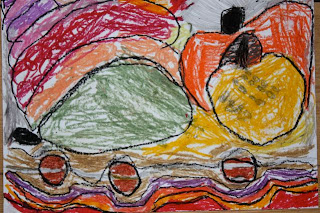When I tell people that I give my children drawing lessons, they often look at me as if I could turn water into wine. Although it's been a magical experience to teach them, the method that I use to do it fortunately doesn't require any supernatural abilities. On a trip to the States just before my son turned three (almost 5 years ago), I was looking for some books with art projects for children. I caught a glimpse of the book below:
Every once in a while you run across a book that changes your life. As soon as I saw this, I knew that I had to have it. I was especially intrigued by the subtitle: "A Creative Method for Adult Beginners, Too". Could I (gasp!), who had always tried to draw, but was unable to overcome my perfectionism, actually learn to draw as well? The answer was yes, and I would get to teach my children and others as well.: )
The premise of Mona Brooke's phenomenal book is that absolutely anyone can be taught to draw. There are basic components in drawing, that once you know them, enable one to learn. It is comparable to the phonetic sounds in a language that help one to learn to read, or notes in music. Knowing these basics principles, according to Brookes, is key to developing drawing skills.
Equally important is having the right attitude, which proved to be the key to helping me as an adult, and is also essential for children to progress. One of Brookes' sayings that has become my mantra with children, is that "in art there are no mistakes, only changes to be made".
The following is a little bit of what I have learned from Ms. Brookes. A typical drawing lesson begins with simple relaxation exercises for the eyes and limbs. Then we review the basic shape "families" by finding things in the room or outside the window that belong to these families. Next, I give each child a set of warm-up exercises that are much like scales and etudes in music. Below is what I gave my 4-year-old daughter on Tuesday. My sketches are in black and hers in red. The object is not for her to make an exact copy of what I have drawn, but rather to fill in the space in a similar manner.
On this particular day, we decided to do a still life of pumpkins, chestnuts and leaves. I recently started letting her use oil pastels and she was very excited about this. Together, we drew the still life with me guiding her through the shape families that the objects are composed of. I drew on my paper and she drew on hers.
Here is the her result below. You'll notice that it is not an exact representation, but that is not the purpose of drawing. When we draw, we interpret what we see rather than making exact copies. What is also interesting in her pictures are the repetition of certain elements that are early indicators of design.

I know for sure that I didn't find this book by accident. Though creative as a child, frustration at not being able to draw realistically led me to give up on myself as an artist. And in another life, I might have studied art education. There were other factors as well that caused me to follow another path, including lack of an adequate art program at the time I was growing up; the Berlin Wall coming down as I was entering university and making the idea of learning Russian irresistable; and the lie that art teachers are only people who couldn't make it in the art world themselves. Anyway, the path that I eventutally followed led to some very valuable life experiences, and when the time was right, God began to resurrect dreams that had been dead so long that I had forgotten about them.